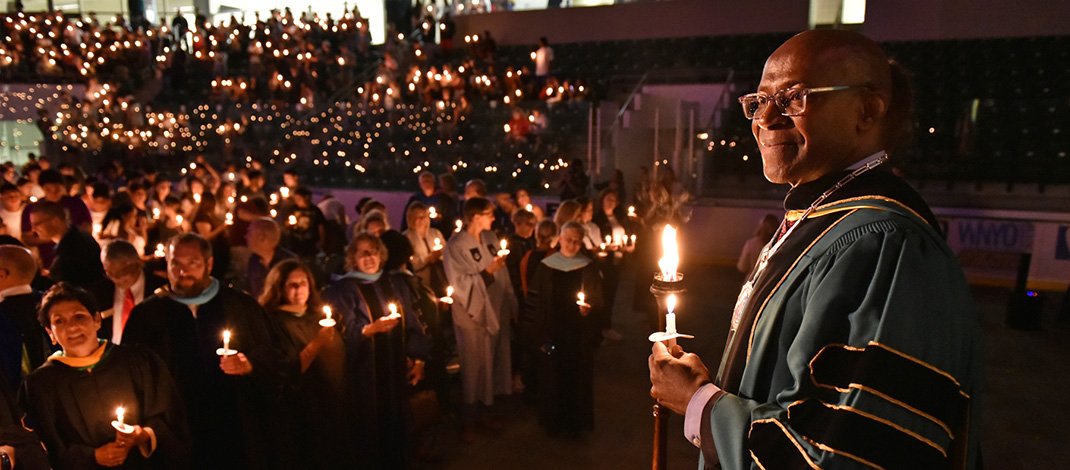New president recalls his educational journey
By Stefan Yablonski
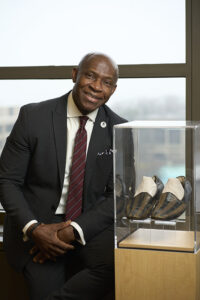
Jason Leone and Ed Gosek have mementos of championship basketball and hockey games, respectively, displayed in their college offices.
In Peter Nwosu’s Culkin Hall office, a pair of decades old shoes has a place of prominence.
They are the shoes of a young immigrant from Nigeria.
They are the shoes of the college’s president.
“You see those shoes?” he asked proudly. “This is the pair of shoes that I wore when I first came to the United States. They don’t define me — they remind me of the journey that I have made and how far I have come. I always say this to students and others, if I as an immigrant in a nation that provides opportunities, if I can become [college] president you too can become a professor … and president!
“Come in your own shoes — but the journey does not define you, it humbles you and indeed prepares you for the next journey. Look at how far these shoes have brought me! If a young man can leave his country — thousands of miles away — learn to adjust and learn to adapt, so can you. Oswego, I’ve loved it since I got here.”
It’s been nearly 40 years since he first arrived in this country as a graduate student. He’s worked at various places around the country winding up as the president of SUNY Oswego.
Nwosu (the “N” is silent) was named on June 6, 2023, as the 11th president of SUNY Oswego, effective Aug. 15, 2023. He is the college’s first Black president.
In a message shortly after his appointment, Nwosu wrote, “It is a great honor and joy to be named your 11th president by the State University of New York Board of Trustees. I find myself humbled to be joining an extraordinary community of teachers, scholars, staff and learners at this storied institution, a community that has kept faith with a transformational promise made 162 years ago — to contribute to the common good by enriching the human spirit and offering to as many as could realize the opportunity to be so enriched.
“As an individual who came to the United States as an immigrant student decades ago and was the first in my family to go to college, I find this promise extraordinarily powerful. Education transforms lives and ignites new possibilities. As your president, I am committed to advancing this promise, working together with you to build on the solid foundation laid by our founders and all those who have preceded me in this role. As we embark together on this new chapter, let’s remember that we are all SUNY Oswego. Let’s continue to advance this powerful promise. Go Lakers!”
He grew up in the southeast region, of Nigeria and graduated with a degree in mass communication and journalism from the Institute of Management and Technology in Enugu, Nigeria.
He decided to continue his education in the United States. It was here that he ultimately decided to become an educator.
Energy and excitement
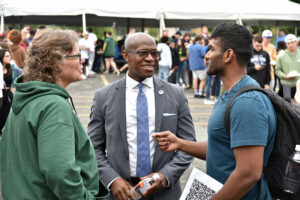
The first 70+ days of his presidency “have been filled with energy and excitement about our strategic direction,” he said in mid-December as the fall semester was drawing to a close.
He is a graduate of the Harvard Institutes for Higher Education and received his Ph.D. in communication studies from Howard University in Washington, D.C., his MA in liberal studies from Towson University and his BA in mass communication and journalism from the Institute of Management and Technology in Enugu.
He was provost and senior vice president for academic affairs and student success at CUNY Herbert H. Lehman College. He previously served as provost and vice president for academic affairs at Clark Atlanta University, a historically Black college or university and Carnegie-designated doctoral research institution.
He also served as associate vice president for academic programs and accreditation liaison officer at California State University, Fullerton, a Hispanic-serving institution and one of the 23 campuses of the California State University System. And he was associate vice president for academic affairs, planning and assessment and special assistant to the president for institutional planning at Tennessee State University, Nashville, one of the then 27 campuses of the Tennessee Board of Regents, the nation’s sixth largest public higher education system.
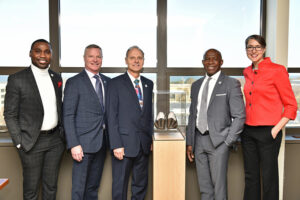
The fact that he’s been in all of those places prepared him to be able to be at Oswego, he said.
Cross-culture adaptation, he explained, allows him to not just adapt to the environment but to the people, a trait he learned from his parents that helps him adjust to new environments.
“And at each one of those places, as a student, it was a learning experience — an exposure to the culture of the United States. It was my first time in the country and I learned a lot of things,” he said.
He knew about (SUNY) Oswego for awhile because he had been a part of the SUNY system [City University of New York], he explained.
“I have come to love this institution. When I visited I liked the institution — thank goodness it wasn’t in the winter! I took a tour and I enjoyed the visit and the people I met. I tend to tell stories like this,” he laughed making exaggerated gestures with his hands. “But, they all add up.”
He said he was “impressed by the golden opportunities in this region.”
“That was an attraction for me because of the work I had done at Lehman. Economic development and upward mobility, educational attainment and diversity and inclusion — the things that always attract me. Those areas tend to draw my attention,” he added.
There was some sunshine and rain during his visit to the campus.
“I remember it was slightly chilly, but rainy and I remember I asked for a hat. They brought me two hats; one was white and one was green and I took the green one. I wore that green one the whole day,” he said.
Snow? “Of course they did mention that,” he laughed. “You have to remember, I came to this country as an immigrant. I came from a country where we don’t necessarily have snow.”
All of his life’s travels prepared him
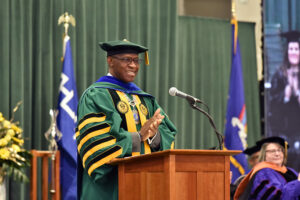
After graduating from Towson University in Maryland and Howard University in Washington, DC, he debated: stay or go home.
“I wasn’t really wanting to be in the United States, quite frankly. A number of immigrants when they come they come to go to school and then they return back to their country,” he said.
However, he wound up in California. While at Howard, he had written a paper for a class; his professor encouraged him to “go fix it up and submit it to a conference.”
And he did.
“It was a conference of the association of journalism and mass com,” he recalled.
“It was the best student research paper for that year. There was a woman at that conference [head of the department of journalism at California State University in Sacramento]. She asked me if I would come and present the paper. And I said, ‘Sure’ — this was my final year as a doctoral student at Howard University.
“I went there and when the presentation was over, she handed me a paper — ‘here’s a job application, can you apply for this job?’ she said. So I did apply and got some offers.”
He finished his Ph.D. work before accepting a job offer and relocating to Sacramento.
“But there was this tension, pull and pull. I wanted to stay, I wanted to go back,” he recalled. “I debated. I decided to stay and began the process of applying for a work visa and all that stuff. I was an assistant professor and that began the extraordinary journey.”
He began his career in higher education as a faculty member at California State University, Sacramento, rising through the ranks to become a tenured full professor of communication studies.
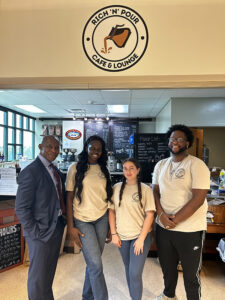
He went on to Atlanta where he became provost, the No. 2 o person at the university, and then moved on to New York.
“All of those journeys — every one of these journeys — for me as an immigrant has been a learning experience,” he said. “I very quickly adapt to become a part of the community.”
His focus has been on increasing educational opportunity.
“It’s so important for me because if it wasn’t for that education, I wouldn’t be here. Education transforms lives — that’s why I’m where I am. Education ignites possibilities,” he said.
If he didn’t have the education, he said he wouldn’t be thinking when that search firm reached out to him that he was prepared.
“I would be thinking I’m not prepared. But with education — ‘oh, I can do this.’ And every step of the way, everywhere I’ve gone … this is what education can do for you,” he said. “There will be rough and tumbles on the journey — but you can get there!”
He recalled meeting one new student from downstate.
“He came to visit [Oswego], fell in love with the place. Then, he said ‘it’s not too far from New York and not too close so my parents won’t come bothering me,’” Nwosu said laughing.
“We are the most mission-critical public comprehensive university in greater Central New York. It’s a lot we have,” he said.
He has had one-on-one meetings (drop in with the president, for example).
“I just go to the Campus Center or another location and people just come … an hour meeting. I go to student events. I don’t tell them I am going to show up. I never confirm it — I surprise them and they love it. I never just make a speech and leave. I’m there with them through the event,” he said.
He has also met with alumni. In New York City he “met with more than 50 for a reception for me there” and also from Florida.
“My job is also external and when I’m external I’m fundraising and friend-raising,” he said. “I’ve also spent time at the Syracuse campus, meeting students there. People really do care about this place. I have felt it and it’s really warming.”
“This institution began in 1861. Our founder came here in 1857 and a few years later started this college and in all those years we have had only 10 presidents. I am the 11th. Each one has expanded on the promise of Sheldon that he laid out for us,” he continued. “That’s what I want to do — build on the foundation laid by our founder and the past leaders of this institution and to further expand the door of opportunity for young people — and adults. That’s the legacy I want to leave behind, that’s the work I aim to do.”
“Our work together is just getting started and we have so much to look forward to achieving in 2024.”
President Nwosu Has 4040 Vision
SUNY Oswego envisions doubling its annual number of graduates by 2040
By Stefan Yablonski
Early on in his tenure, SUNY Oswego President Peter Nwosu, Ph.D., unveiled “Vision 4040: Expanding SUNY Oswego’s Promise,” described as “a bold plan to increase upward mobility and advance regional economic development.”
The college envisions doubling its annual number of graduates by 2040 to meet the needs of the Central New York region, he explained.
“Before COVID-19, it was 2,000. For 10 years that’s 20,000. What if we doubled it by 2040?” he asked rhetorically. “If we are going to remain relevant as an institution we are going to have to respond to regional needs.”
Only 9% of 18-24 year olds have college education in Oswego County, he said.
“If you look at all Central New York, it’s 12% — only the New York City area is in the 20% range. We have a declining enrollment because we have a decline in birth rates that is significant in the northeast corridor of the United States. It’s all over the country, but its impact is greater here,” he said. “We also have an aging population. You need young people to continue to strengthen the population; the current workers are aging out. If you do nothing, you have a problem.”
“Vision 4040: Expanding SUNY Oswego’s Promise” establishes a pathway for the college to stabilize degree attainment of 4,000 awards per year — or 40,000 per decade — by the year 2040, he said.
“Vision 4040 builds upon SUNY Oswego’s mission to contribute to the common good and aligns with SUNY Chancellor John King Jr.’s and SUNY system’s four pillars: (1) student success, (2) research and scholarship, (3) diversity, equity and inclusion and (4) economic development and upward mobility,” he added.
“As an individual who came to the United States as an immigrant student decades ago and was the first in my family to go to college, I find this promise extraordinarily powerful,” Nwosu told Oswego County Business Magazine during a late December interview. “Education transforms lives and ignites new possibilities. As Oswego’s president, I am committed to advancing this promise, working together to build on the solid foundation laid by our founders and all those who have preceded me in this role.”
Central New York remains undereducated
The five counties of Central New York remain undereducated in higher education relative to the rest of the state — especially compared to the most industrialized counties in the state, such as around New York City and Long Island, he said.
Across 3,143 counties in the nation, the percentage of young adults aged 18 to 24 who have already completed at least a bachelor’s degree ranges from zero in several places up to 55% in Arlington County, Virginia, and 90% in Wibaux County, Montana.
Oswego’s rate of 9% lags the national value of 12%, which the five-county region has achieved.
To move CNY’s rate of baccalaureate degree attainment up to the state’s 18% rate would require educating 5,000 more young adults 18 to 24 years old, Nwosu explained.
Similarly, the degree attainment rate of adults 25 and older in Oswego County (20%) lags the CNY rate of 31%, which itself lags the national value of 33% and significantly behind the New York state rate of 37% and the 40% associated with the most economically productive region in the state’s southeast corner.
“To bring CNY up to the statewide rate would require providing a four-year degree opportunity to 32,000 more adults over age 25 that live in the region,” he said. “That’s why I launched 4040. It talks about growth; that really speaks to the challenges we are facing. It paints a picture of where I want to take the university.”
Points for growth
The work of doubling the number of awards granted annually to 4,000 requires many significant planning decisions. A few of these include:
• Increasing the number of transfer students.
• Re-engaging former SUNY Oswego students and alumni.
• Growing enrollment pipelines into SUNY Oswego from population dense regions, cities, states and countries.
• Increase retention and completion rates.
• Increasing the awareness, utilization and impact of SUNY Oswego’s Syracuse Campus.
• Continuing to develop online majors, programs and courses.
By preparing for the expected business and population growth in Central New York, the global demographic and population shifts and the continued changes in market demand for flexibility in course format and delivery, SUNY Oswego will be ready and able to double the number of graduates annually by 2040, he said.
Working toward Vision 4040, SUNY Oswego will expand its impact on more students, enabling them to achieve more social mobility and in turn make a bigger impact on their communities — SUNY Oswego will be a more powerful economic engine for the region and its graduates will carry forth a spark to ignite more growth, he said.
Nwosu’s Journey
2023 – Present: SUNY Oswego
President and professor of communication studies
2019-2023: Herbert H. Lehman College, The City University of New York, New York
Provost and senior vice president for academic affairs and student success and professor of journalism and media studies
2016-2019: Clark Atlanta University, Atlanta, Georgia
Provost and vice president for academic affairs and professor of communication
2014-2016: California State University, Fullerton
Associate vice president for academic programs; accreditation liaison officer; and professor of communication studies
2010-2013: Tennessee State University, Nashville, Tennessee
Associate vice president for academic affairs, planning and assessment (2011- 2013) and professor of communication; special assistant to the president for institutional planning (2010-2011); and professor of communication
2004-2011: California State University, Northridge, California
Special assistant to the provost for academic planning and diversity initiatives (2009-2010); professor of communication studies American Council on Education Fellow, posted to Tennessee State University, Nashville, Tennessee (2008-2009); chairman, department of urban studies and planning (2007-2008); chairman, department of communication studies (2004-2007); director, Center for Human Relations (2005-2010); professor of communication studies (leave of absence from March 2010 through August 2011).
1990-2004: California State University, Sacramento, California
Associate chairman, department of communication studies (1994-1995); director, Fulbright-Hayes Group Projects Abroad Program (1994-1995); professor of communication studies (2000-2004); associate professor of communication studies (1994-2000); assistant professor of communication studies (1990-1994).
Nwosu is a graduate of the Harvard Institutes for Higher Education and received his Ph.D. in communication studies from Howard University, his Master or Arts degree in liberal studies from Towson University, and his Bachelor of Arts in mass communication and journalism from the Institute of Management and Technology in Enugu, Nigeria.
What Happened to the Officer-in-Charge Mary Toale
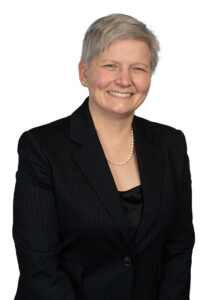 Mary C. Toale, who led SUNY Oswego after the retirement of longtime president Deborah Stanley, has been selected to serve as SUNY Geneseo’s new provost and vice president for academic affairs. She assumes the role on March 28.
Mary C. Toale, who led SUNY Oswego after the retirement of longtime president Deborah Stanley, has been selected to serve as SUNY Geneseo’s new provost and vice president for academic affairs. She assumes the role on March 28.
“I am thrilled to welcome Dr. Toale to SUNY Geneseo’s leadership team and community,” President Denise A. Battles said. “Her proven track record and unwavering commitment to academic excellence give me great confidence in her ability to be a dynamic and visionary leader for Geneseo. As our new chief academic officer, Dr. Toale brings a wealth of experience to one of the nation’s premier public liberal arts colleges. With her leadership, we aim to achieve the objectives outlined in our strategic plan, build upon our collective successes and fully realize Geneseo’s highest goals.”
She is currently deputy to the president for strategy and planning at SUNY Oswego, where she was officer-in-charge from January 2021 through August 2023, after serving the university in various leadership roles since her arrival in 2014.
“I am honored to join SUNY Geneseo as the next provost and vice president for academic affairs,” Toale said. “The outstanding reputation of Geneseo’s faculty, staff and students and shared commitment to excellence, equity and student success is inspirational.”
Toale will succeed interim provost Daniel Blankenship, who has served in the role since August 2023.

